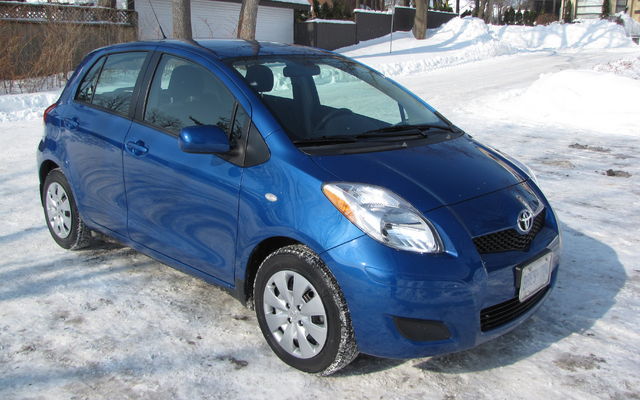The Toyota Yaris LE Hatchback: 2,000 kilometres later
This year, we took a five-door Toyota Yaris Hatchback LE to go to Detroit, where I attended the Detroit Auto Show for the eighteenth time. Now, I didn’t just choose this car at random. I wanted to get to know this vehicle a little better after having tried the previous version of the Yaris sedan in the past. Having said that, I was fully aware that, despite bearing the same name, these two vehicles are very different as they are made with different customers in mind.
More mature style
The new version of the Toyota Yaris, and the hatchback in particular, has had somewhat of a facelift, making it a little more mature and sexy than the previous version. However, this flirty look has been left off of the sedan, which remains rather conventional in terms of style.
More spacious than you think
If you ask me, the most interesting Yaris is the five-door hatchback. The fit and trim is top-notch with solid materials, quality and good taste, regardless of the fact that the Yaris is considered an economy vehicle.
Toyota claims this little hatchback seats five. I’m betting it’s able to comfortably fit four good-size adults, despite its modest dimensions. The high and firm bucket seats provided just the kind of comfort that my colleague and I were looking for, even though we knew that this European style was not necessarily the preference of most North American drivers. We shared the driving doing three-hour shifts non-stop, and I can report that neither of us felt the slightest bit tired after doing a stint behind the wheel.
The storage spaces are numerous, but often on the small side. The cargo space can go from 228 to 950 by lowering the back seat. On our way back from Detroit, we were fully loaded down with big bags of promotional material from the show, but the Yaris didn’t let us down. In fact, there was even space to spare. Now, if you were to be two couples on board, the Yaris Hatchback would be a lot less generous in terms of how much cargo space it offered. For that kind of travel, you’d be better off with the Yaris sedan, which features a wide, deep trunk.
Reliable mechanics for less
For 2009, the Toyota Yaris is once again putting its trust in the trusty 1.5-litre 4-cylinder engine with fuel injection and VVT-i variable valve timing. This engine produces 106 hp at 6,000 rpm and 103 lb.-ft. at 4,200 rpm. The version we were given for our long road trip had an automatic 4-speed transmission, which proved very efficient.
Thanks to the vehicle’s low weight (1052 kg), the engine offers both power and zip whenever you so much as tap the pedal. However, it will start to growl if you ask too much of it as you start out. Throughout our 2,000 km drive, the engine was very discreet while we were at “cruising speed,” which we set to 110km/hr.
Not afraid of snow
Nope, the little Yaris is not just a city car. On our way to Windsor, we were hit with snow (but thankfully no wicked gales) for some 160 km, of which at least 50 included roads covered in snow and ice. In my mind, the Yaris Hatchback proved that little cars handle better than big ones in these conditions. In fact, my colleague and I were impressed at how well it did compared to the heavyweights we passed along the way. But be careful, this spunky little car is nonetheless sensitive to wind, if the gusts are strong. When the wind is whipping along, it may be wise to limit your trips in the Yaris Hatchback.
The power of savings
After completing nearly 2,000 km at the wheel of this vehicle, at a consistent speed of 100km/hr, our automatic Toyota Yaris posted a fuel consumption of 7.0 litres/100 km. For everyday driving, it averaged 7.6 litres/100 km – and that’s in winter conditions.
A word from my colleague Henri Michaud
Henri also came away with good thoughts about this car. He was impressed with the soundproofing, its wide windshield, its seats that hug your sides, and the speed at which it heats up. He was pleasantly surprised by its handling and fuel consumption, too. In contrast, he found that the central instrumentation took some getting used to, and the cup holders were frankly mediocre. And finally, he concluded that the cargo space was insufficient for certain needs.












